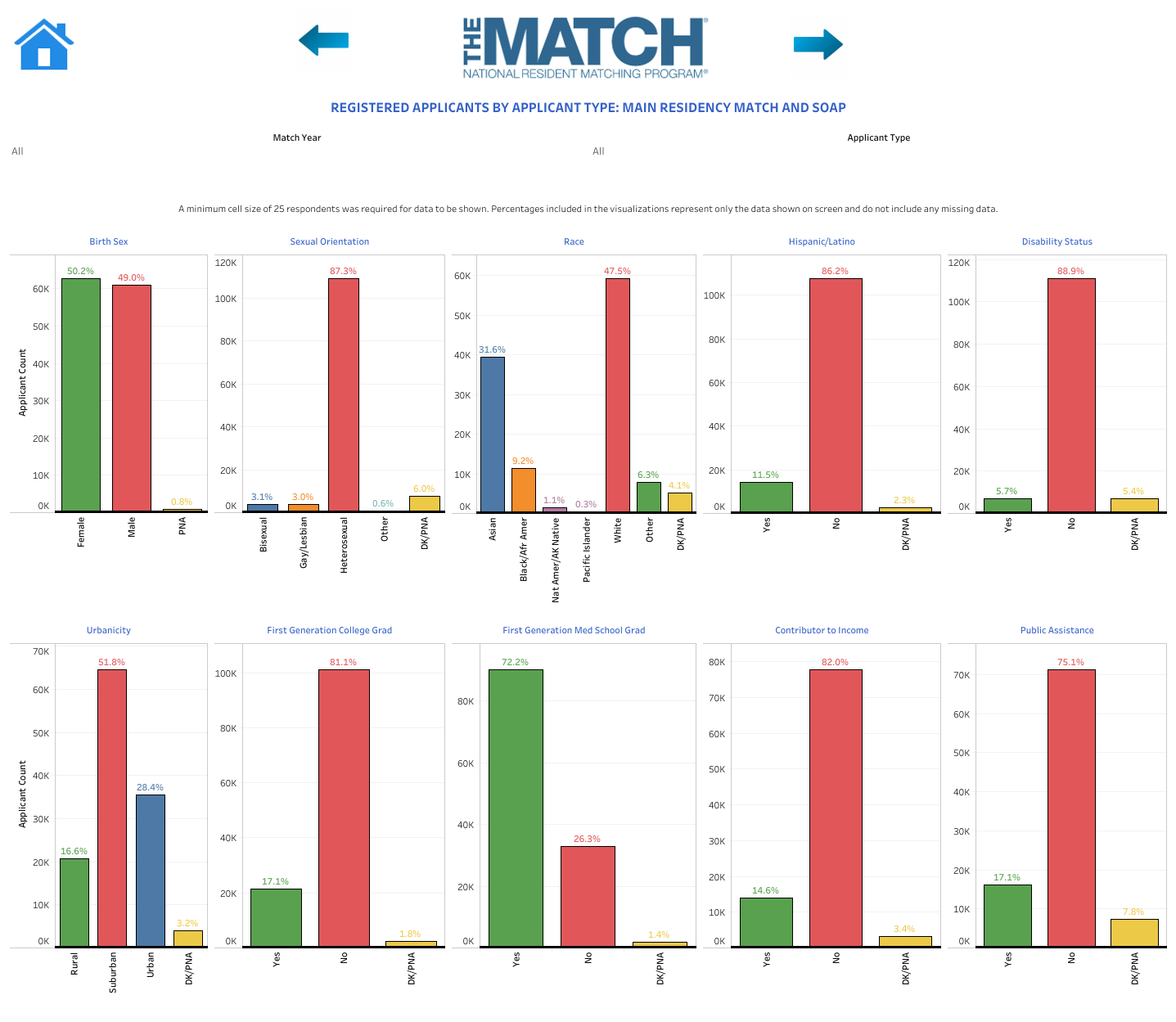Charting Outcomes™: Demographic Characteristics of Applicants in the Specialties Matching Service®(SMS®)
National Resident Matching Program® (NRMP) is pleased to report findings of the demographic data collection from applicants to the Specialties Matching Service (SMS®) have been updated to include data for appointment year 2025.
Purpose:
The aim of applicant voluntary demographic data collection and analysis is to advance understanding of relationships that exist among the unique characteristics of applicants, the specialties they pursue, and their experience in The Match. The NRMP makes findings available to the community to expand the transparency and understanding of the matching process, encourage discussion and reflection about applicant matriculation into physician training programs and access to preferred specialty, and improve the community’s understanding of the physician workforce.
Charting Outcomes in the Match: Demographic Characteristics of Applicants in the Specialties Matching Service has been built using data visualization software and draws from the demographic questions asked of applicants registering for the SMS in the NRMP’s Registration, Ranking, and Results (R3) system. The questions cover characteristics including but not limited to:
- Sex assigned at birth
- Sexual orientation
- Race identities
- Hispanic/Latinx/Spanish ethnicity
- Disability status and accommodations sought during residency
- Urbanicity of childhood rearing environment
- First-generation college and medical school graduation statuses
How to Interpret the Data
Charting Outcomes in the Match: Demographic Characteristics of Applicants in the Specialties Matching Service consists of two sections:
- Narrative text that describes the background and methods from the NRMP’s demographic data collection; and
- A series of visualizations of the demographic composition of each subspecialty and, within subspecialty, Match outcomes. The number and granularity of the visualizations depend on the sample sizes for each of the data cells of interest (see below, Data Considerations).
Drop-down menus at the top-center of the dashboard allow users to select the data they would like to view. Across the visualizations there are six drop-down menus to utilize:
- Appointment Year: Viewers can choose an individual year of data, or they can view cumulative data by selecting multiple years (or selecting “All”).
- Preferred/Matched Subspecialty: These are multiselect menus allowing the viewer to select individual subspecialties to view, or any combination of subspecialties listed.
- Preferred/Matched Specialty Group: To include as many of the smaller subspecialties as possible in this report, some were rolled up into superordinate categories based on their Accreditation Council for Graduate Medical Education (ACGME) classification. These menus will be particularly useful for those viewers who are interested in viewing the data by an overarching specialty rather than a specific subspecialty. For example, if a viewer is interested in viewing all Internal Medicine subspecialties, they can select “Internal Medicine” from this dropdown menu rather than selecting the individual subspecialties included in this category.
NOTE: Once a viewer selects from either the Preferred/Matched Subspecialty menu or the Preferred/Matched Specialty Group menu, the viewer must set the menu back to “All” to reset both menus to the full list of options.
- Applicant Type: Viewers can choose which applicant types they are interested in viewing. Options include U.S. MD graduate, U.S. DO graduate, U.S. IMG, non-U.S. IMG, and Canadian. See the Definitions section below for details on each applicant type.
DEFINITIONS
Active Applicant
An applicant who submits a certified rank order list of programs.
Applicant Type1
- Graduates of U.S. medical schools:
- Graduates of U.S. medical schools accredited by the Liaison Committee on Medical Education (LCME); also referred to as U.S. MD graduates.
- Graduates of U.S. medical schools accredited by the Commission on Osteopathic College Accreditation (COCA); also referred to as U.S. DO graduates.
- Graduates of Canadian medical schools: Graduates of Canadian medical schools accredited by the Committee on Accreditation of Canadian Medical Schools (CACMS); also referred to as Canadian graduates.
- Graduates of Fifth Pathway programs: Graduates of a U.S. Fifth Pathway program; also referred to as Fifth Pathway graduates.
- U.S. citizen graduates of international medical schools: A U.S. citizen who attended an international medical school; also referred to as U.S. IMGs.
- Non-U.S. citizen graduates of international medical schools: A non-U.S. citizen who attended an international medical school; also referred to as non-U.S. IMGs.
1 While the NRMP defines six types of applicants, Fifth Pathway applicants were excluded from this report.
Appointment Year
The year a matched fellow begins their fellowship appointment (this is not always the same as match year).
Matched Subspecialty
The subspecialty of the program to which an applicant matches through the Specialties Matching Service.
Preferred Subspecialty
The subspecialty of the program ranked first on the rank order list.
Registered Applicant
An applicant who has registered to participate in the Main Residency Match in the NRMP’s Registration, Ranking, and Results® (R3) system.
Specialties Matching Service (SMS)
The collection of Fellowship Matches sponsored by the NRMP that places applicants into subspecialty training programs in the United States.
Data Considerations:
- A minimum cell size of 25 respondents was required for all data points included in the report. In some cases, the threshold affected which demographic characteristics could be reported (e.g., specific disability types and disability accommodations sought during medical school could not be reported).
- The minimum cell size requirement also restricted which response options within a characteristic could be reported (e.g., race could be reported for a subspecialty in appointment year 2023 but only for specific race types like Black/African American, Asian, and White).
- In future years, as sample sizes accrue, the NRMP will report more results, including more variables, more response options, and higher granularity with more subgroup-specific (e.g., by applicant type) findings.
- Not all applicants consented to provide demographic data for research and not all those who consented to provide the data answered all questions; accordingly, missing data exist in all characteristics.

